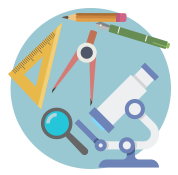The Power of Collaborating with Experts for Precision and Accuracy
Collaborating with scientists, researchers, and experts in relevant fields is a pivotal step that elevates the quality and accuracy of scientific illustrations to new heights. This synergy between artistic creativity and scientific knowledge serves as a potent catalyst, enriching the visual representation of complex concepts. Here's why this collaboration is of paramount importance:
Precision and Authenticity:
Scientists and researchers possess an intricate understanding of the subject matter. Their insights ensure that the illustrations accurately depict scientific phenomena, structures, and processes. This collaboration guarantees that every detail is portrayed with utmost precision, enhancing the credibility and authenticity of the visuals.

Bridge of Communication:
Complex scientific ideas can be challenging to translate into visuals that are easily comprehensible to a broader audience. Collaborating with experts creates a bridge of communication. They provide invaluable guidance in simplifying intricate concepts, enabling you to convey the intended message effectively.
Contextual Enrichment:
Experts bring contextual depth to the illustrations. Their input ensures that the visuals capture the real-world context, enriching the narrative and enabling the audience to connect with the subject matter on a deeper level.
Visual Storytelling:
Effective scientific illustrations go beyond mere depiction; they tell a visual story. Collaborating with experts allows you to infuse storytelling elements that resonate with the scientific community and the general public alike.
Mutual Learning:
The collaboration is a two-way street. As an illustrator, you gain insights into the nuances of the subject, expanding your knowledge base. Simultaneously, experts learn how to translate their complex research into accessible visuals, enhancing their communication skills.
Enhanced Creativity:
Collaborating with experts challenges your creativity to explore innovative ways of representing intricate concepts. This symbiotic relationship often leads to novel and captivating visual solutions.
Professional Credibility:
A collaboration rooted in expertise enhances your professional credibility. The endorsement of experts adds weight to your work, positioning you as a trusted partner in visually communicating scientific ideas.

Conclusion
In essence, the collaboration between scientific illustrators and experts cultivates a harmonious blend of artistic finesse and scientific accuracy. This synergy not only raises the caliber of scientific illustrations but also ensures that the visual representation is a beacon of enlightenment for all who engage with it.
Examples of Collaboration Between Scientific Illustrators and Researchers
Certainly, here are 20 examples of cases in which a scientific illustrator can seek knowledge from scientists, researchers, and experts to enhance the quality and accuracy of their scientific illustrations:
Anatomy Illustrations:
When depicting intricate anatomical structures, seek guidance on accurate placement, proportions, and relationships between different components.

Cellular Processes:
For illustrations of cellular processes, inquire about the sequence of events, molecular interactions, and spatial arrangements within the cell.
Geological Formations:
When illustrating geological landscapes, consult experts for insights into rock formations, erosion patterns, and geological time scales.
Botanical Illustrations:
Seek expertise on plant species, leaf arrangements, flower structures, and growth patterns for realistic botanical illustrations.

Astronomical Phenomena:
When visualizing celestial bodies or events, collaborate with astronomers to ensure accurate depictions of positions, sizes, and movements.
Microscopic World:
Inquire about the details of microscopic organisms, cellular organelles, and subcellular structures for accurate representations.
Ecosystem Dynamics:
Collaborate with ecologists to depict interactions between species, food chains, and ecological dynamics in natural habitats.
Genetic Sequences:
When illustrating genetic sequences, work with geneticists to accurately represent DNA structures and sequence variations.
Medical Procedures:
Seek guidance from medical professionals to illustrate surgical procedures, medical devices, and anatomical changes.

Archaeological Reconstructions:
Inquire about historical and cultural contexts from archaeologists to create accurate reconstructions of ancient civilizations.
Neurological Processes:
Inquire about neural pathways, brain regions, and neurotransmitter interactions for illustrations related to neuroscience.
Weather Patterns:
Consult meteorologists to accurately depict atmospheric phenomena such as cloud formations, weather fronts, and atmospheric layers.
Chemical Reactions:
When illustrating chemical reactions, work with chemists to ensure accurate depictions of molecular structures and reaction mechanisms.

Oceanic Environments:
Seek insights from marine biologists to accurately depict marine life, coral reefs, and underwater ecosystems.
Evolutionary History:
Collaborate with experts in evolutionary biology to create illustrations that showcase the evolutionary history of species.
Paleontological Reconstructions:
Collaborate with paleontologists to create accurate reconstructions of extinct species based on fossil evidence.
Physics and Mechanics:
Seek guidance from physicists for accurate depictions of physical principles, mechanical systems, and engineering concepts.
Climate and Environment:
Collaborate with environmental scientists to illustrate climate change effects, ecosystems, and environmental impacts.

Medical Imaging Interpretation:
Work with medical imaging specialists to accurately interpret and illustrate medical images such as MRI or CT scans.
Technological Innovations:
Inquire with engineers or technologists for accurate depictions of cutting-edge technologies, inventions, and scientific advancements.
By actively engaging with experts in these diverse fields, scientific illustrators can ensure that their illustrations are not only visually captivating but also scientifically precise and informative.
Engaging Scientists and Experts to Enhance Scientific Illustrations
Approaching scientists, researchers, and experts to enhance the quality and accuracy of your scientific illustrations involves a combination of professionalism, genuine interest, and effective communication. Here's a step-by-step guide on how to successfully engage with them:
1. Research and Familiarize:
Before reaching out, thoroughly research the expert's work and their field of expertise. This demonstrates your genuine interest and prepares you for informed discussions.

2. Craft a Compelling Introduction:
Write a concise and respectful introductory email or message. Clearly state who you are, your background as a scientific illustrator, and your interest in collaborating to create accurate visuals.
3. Highlight Mutual Benefits:
Emphasize how their expertise can elevate the accuracy and educational value of the illustrations. Explain how their insights will contribute to conveying complex ideas more effectively.
4. Showcase Your Work:
Attach or provide links to samples of your previous scientific illustrations. This demonstrates your skill and professionalism, reassuring them of your ability to translate their knowledge into visual form.
5. Specific Areas of Interest:
Identify specific areas within their expertise that align with your illustration needs. Mention how their insights can enhance the accuracy of your depictions in those areas.
6. Express Enthusiasm:
Convey your enthusiasm for their work and the potential collaboration. Express your eagerness to learn from their expertise and create visuals that contribute to scientific communication.

7. Propose Collaboration:
Suggest potential ways to collaborate, such as virtual meetings, exchanging emails, or even visiting their research site if feasible. Be flexible and respectful of their time constraints.
8. Timely Follow-Up:
If you don't receive an immediate response, follow up politely after a reasonable period. Persistence and professionalism go a long way in building meaningful collaborations.
9. Respect Their Expertise:
During discussions, listen attentively and ask thoughtful questions. Acknowledge their insights and expertise to create a collaborative and mutually respectful environment.

10. Clear Communication:
Clearly outline the scope of the collaboration, your expectations, and the potential outcomes. Discuss how their input will be integrated into the illustration process.
11. Regular Updates:
Keep them informed about the progress of the project and seek their feedback at key stages. Regular communication ensures alignment and prevents misunderstandings.
12. Acknowledge Contributions:
Once the project is complete, acknowledge and credit their contributions appropriately. This reinforces a positive and respectful working relationship.
13. Offer Benefits or some kind of payment:
If feasible, offer to provide them with copies of the final illustrations for their use or for sharing in their professional circles. This adds value to the collaboration.
14. Thank Them:
Express gratitude for their collaboration, whether the project is small or extensive. A sincere thank-you note or gesture goes a long way in maintaining a positive connection.

Conclusion
By approaching scientists, researchers, and experts with respect, professionalism, and a genuine desire to learn from their expertise, you'll establish fruitful collaborations that enrich the accuracy and impact of your scientific illustrations.
